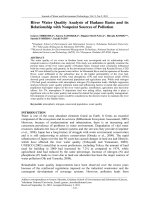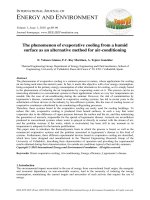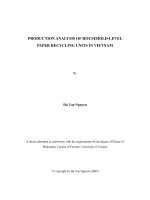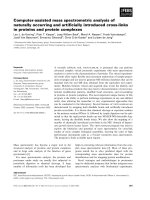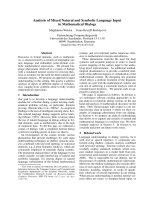ANALYSIS OF PASSIVE COOLING AND HEATING POTENTIAL IN VIETNAM USING GRAPHICAL METHOD AND TYPICAL METEOROLOGICAL YEAR WEATHER FILE
Bạn đang xem bản rút gọn của tài liệu. Xem và tải ngay bản đầy đủ của tài liệu tại đây (989.75 KB, 6 trang )
ANALYSIS OF PASSIVE COOLING AND HEATING POTENTIAL IN
VIETNAM USING GRAPHICAL METHOD AND TYPICAL
METEOROLOGICAL YEAR WEATHER FILE
Anh-Tuan Nguyen*, Sigrid Reiter
LEMA, University of Liège, Belgium
Address: LEMA, Bât. B52/3, Chemin des Chevreuils 1 - 4000 Liège; Email: *
ABSTRACT
This paper studies the potential to improve thermal comfort in Vietnam thanks to passive
strategies. First, a thermal comfort zone for the Vietnamese is proposed by using the PMV-PPD
heat balance model of Fanger and the effects of adaptive mechanism of the people living in
tropical hot humid region. Then, the comfort zone is enlarged using the algorithms proposed by
the authors to calculate the effects of the passive heating and cooling strategies. Typical
Meteorological Year (TMY) weather data are used for graphically printing of hourly
environmental parameters on the psychrometric chart and for climate analysis, subsequently. The
limitation and the scope of this method are also specified. Results of this study show that in all
climatic zones of Vietnam, natural ventilation is an efficient cooling solution, low-cost and easy to
apply. Thermal comfort improvement of natural ventilation strategy varies with the climatic zones,
increasing from 17.1% in Hanoi, 21% in Danang to 31.4% in Hochiminh city. Meanwhile, passive
solar heating is not really effective since winter in Vietnam is usually not too cold and the
capacity of the passive solar collector system is usually limited. Direct evaporative cooling also
has a great cooling effect compared with that of natural ventilation, but significant humidity
augmentation in the air in hot and humid conditions may be inappropriate. Seasonal analysis
reveals that natural ventilation gives higher performance than other methods and is particularly
effective in mild seasons. During 12 months in Hanoi, the analysis clearly shows significant
contribution of natural ventilation in the period from April to October during which comfort
period achieved might vary from 30% to 81%. The combination of all passive strategies
considerably improves thermal comfort: 22.6%, 31.7% and 47.6% of total time in Hanoi, Danang
and Hochiminh city, respectively. Finally, the findings of this study indicate that conventional
heating and cooling methods are also needed during extreme weather conditions in summer and
winter, especially in Hanoi.
1. INTRODUCTION
A full understanding of local climate is the main requirement for the designs of climate responsive
architecture towards sustainable development. There have recently been some weather tools
developed for climate analysis, but they are usually aimed to the application on people living in
temperate climate and thus inappropriate when being applied to people living in hot humid
climate. This study proposes a simple method for hot humid climate analysis with which the
potential of comfort improvement of passive cooling and heating strategies in many regions of
Vietnam is examined. In this analysis three typical sites, including Hanoi (21° North), Danang
(16° North) and Hochiminh city (11° North), have been selected. They represent 3 climatic
regions in the North, Centre and South of Vietnam.
The method proposed will be carried out through three steps: (1) proposition of an appropriate
comfort zone for people living in hot humid climate; (2) printing of climate data and (3)
quantitative analysis and assessment of heating and cooling potential of passive strategies.
2. COMFORT ZONE FOR PEOPLE LIVING IN HOT HUMID CLIMATE OF VIETNAM
There is still an argument that under a specific condition the comfort zone for different climatic
regions is unchanged. Based on Fanger’s study , ASHRAE [1] reported that under steady-state
Proceedings CISBAT 2011, Lausanne, Switzerland
323
condition, “people cannot physiologically adapt to preferring warmer or colder environments, and
therefore the same comfort conditions can likely be applied throughout the world”. However, the
comfort zone proposed by ASHRAE standard [2] seems to be inappropriate for Vietnamese since
it neglects the adaptation to the humidity of people living in hot humid climate. Some computer
weather tools also failed to predict comfortable period for the climate of Vietnam since they used
inappropriate comfort boundaries. The comfort zone for Hanoi proposed by Climate consultant
software [3] (using comfort model of ASHRAE standard 55) gives that only 4.9% of total time in
a year should be comfortable, which is extremely low. Also in Hanoi, Fig. 1 shows the comfort
prediction of another weather tool [4] in which Szokolay’s method [5] was adopted. The
significant weakness of this method is that a steady-state condition was imposed, but the adaptive
comfort model was employed to find neutral temperature. According to this prediction, only 2.5%
of total time in a year is considered comfortable, extremely underestimating the real thermal
environment.
Figure 1: Incorrect prediction of comfort zone for Hanoi by weather tool [4]
The above analysis indicates that it is essential to create appropriate thermal comfort boundaries
for Vietnamese considering the adaptation to humidity. This study proposes a thermal comfort
zone for Vietnamese as shown in Fig. 2 using a steady-state thermal comfort model. This comfort
zone, which is applied for a normal Vietnamese (height of 1.65m and weight of 60kg) in
sedentary work (60W/m2 – 1 met) and in still air condition (0.15 m/s), is established for 90%
occupant acceptability. Clothing insulation values may vary from 0.5 clo (summer) to 1 clo
(winter), reflecting the change of clothing style to suit seasonal weather.
Figure 2: Comfort zone proposed for Vietnamese and its enlargements
The cooler and warmer boundaries of the comfort zone are defined by the PMV-PPD model (-0.5
≤PMV≤0.5; PPD ≤ 10%). These boundaries are the lines AB and CD respectively (Fig. 2). Point
B and C rely on 70% RH since PMV-PPD model is assumed to be inaccurate at RH higher than
70% [6]. These lines nearly coincide with the lines of constant ET*.
The lower humidity lever of the comfort zone was fixed at 30% relative humidity since it hardly
falls below this value in humid climate and Vietnamese are not acquainted with dry nose, throat,
eyes and skin caused by extremely dry air. The upper humidity limit is more complicated due to
324
Proceedings CISBAT 2011, Lausanne, Switzerland
lack of specific survey on this issue. ASHRAE [2] specifies an upper humidity ratio limit of 0.012
kg
w
/kg
dry air
. That is based on avoiding condensation and mold growth in the ducts of HVAC
system [7] and hygienic conditions rather than on human thermal comfort requirements. Besides,
in hot humid climate surface temperatures are closer to the ambient air temperature which is
normally very high. This reduces the potential for condensation and mold growth, allowing the
higher acceptable humidity limit in hot humid climate. Olgyay [8] proposed around 78% relative
humidity as upper limit for U.S. moderate zones inhabitants. In his book, Givoni [9] suggested
that upper limit could be enlarged to 90% relative humidity and up to 93% with ventilation. Pham
[10] conducted a small comfort survey in Vietnam in 2002. His result revealed that over 80% of
subjects found to be thermally comfortable at 28.5 – 29.5°C and 90% relative humidity. Adaptive
comfort standards [2,11] even indicated that no humidity limit was required for thermal comfort.
Based on above-mentioned studies and findings, the upper limit of comfort zone shown in Fig. 2
was fixed at 90% relative humidity. In summer, this humidity limit may be even enlarged to 95%
under effect of a wind speed of 0.8 – 1m/s due to the effect of air change.
3. COMFORT CONTROL POTENTIAL ZONE BY USING PASSIVE COOLING AND HEATING
STRATEGIES
3.1 Passive cooling by natural ventilation
Precise comfort improvement by elevated air speed has not been established. Both ASHRAE 55
[2] and ISO 7730 [6] recommend a maximum wind speed of 0.82 m/s for sedentary activity.
However, this mainly bases on the requirement of stabilization of loose paper rather than human
draught. It is not difficult to create thermal comfort for a person exposed to a wind velocity of 1
m/s [12] and under overheated conditions air velocities up to 2 m/s may be welcome [5]. The
velocity of 1 m/s is, therefore, adopted in comfort enlargement shown in Fig. 2. Temperature
offset above warmer limit of comfort zone by increased air velocity is strictly followed these two
standards [2,6]. This enlargement neglects the effect of humidity on cooling potential of air
movement since this effect is rather minor.
3.2 Passive cooling by Direct evaporative cooling
In direct evaporative cooling, water evaporates directly into the airstream, reducing the air’s dry-
bulb temperature and raising its humidity, but wet-bulb temperature is always unchanged. The
total heat content of the system does not change, therefore it is said to be adiabatic. The cooling
performance or leaving air temperature of the cooler may be determined:
T
LA
= T
DB
– (T
DB
– T
WB
) * ε (1)
where
T
LA
= Leaving air dry-bulb temp; T
DB
= Inlet Dry-bulb temp; T
WB
= Inlet Wet-bulb temp; ε = Efficiency of the
evaporative cooler.
The cooler efficiency usually runs between 80% and 90%. Under typical operating conditions, an
evaporative cooler will nearly always deliver the air cooler than 27°C. A typical residential
'swamp cooler' in good working order should cool the air to within 3°C – 4°C of the wet-bulb
temperature [13]. Based primarily on previous experiment of other authors, Givoni [14] stated that
ambient air can be cooled by 70–80% of the DBT-WBT difference. This observation led him to a
comfort limit of ambient DBT of 42°C controlled by direct evaporative cooling. It is impractical
to lower dry-bulb temperature more than 11°C by direct evaporative cooling [5], thus in Fig. 2,
comfort zone was enlarged 11°C along wet-bulb temperature line.
3.3 Passive heating using Solar energy
This section will examine the lowest temperature at which the solar gain by the passive solar
system (e.g. trombe wall system, massive masonry wall, south-facing glazing façade,
sunspaces…) can match the heat losses of the building. Useful solar energy gained by a solar
collector can be estimated on the following basis:
24
(2)
Proceedings CISBAT 2011, Lausanne, Switzerland
325
where
Q
u
= useful energy delivered by solar collector in a day, Wh; A
c
= solar collector area, m2; I
t
= Global solar
irradiance, Wh/m2.day; τ = transmittance, dimensionless; α = absorptance, dimensionless; U
L
= overall heat loss
coefficient, W/(m2·K); t
p
= average temperature of absorbing surface, °C; t
a
= atmospheric temperature, °C
Some parameters in equation (2) are very difficult to identify. For convenience, equation (2) is
empirically simplified using solar collector efficiency η (the fraction between useful heat
distributed and total solar radiation falling on a solar collector system):
(3)
According to ASHRAE [15], η can theoretically achieve maximum value of 0.82. For preliminary
calculation, η is about 0.5. The limiting condition will be when the solar heat input equals the heat
loss (ignoring heat loss caused by ventilation and infiltration):
*24 (4)
and then rearranging for t
a
:
(5)
where
U = building overall thermal transfer value (U-value), W/m
2
.K; A = total building surface area, m
2
; t
i
= lower
limit of comfort temperature - indoor, K; t
a
= atmospheric temperature at which thermal balance is achieved, K
Assume a standard building of 4.0x4.0x3.6 m with overall thermal transfer value (U) of 1.58
W/m
2
.K; solar collector area (A
c
) of 2.0 m
2
on the roof; t
i
= 22.3°C at RH = 30% (see Fig. 3); total
solar irradiance (I
t
) (coldest month) of Hanoi, Danang and Hochiminh city are 2678, 3718 and
5161 Wh/m2.day [16], respectively. Thus t
a
for Hanoi, Danang and Hochiminh city are 21.51°C,
21.21°C and 20.78°C. These are lowest temperature at which heat delivered by a passive solar
system can compensate for achieving comfort temperature.
4. CLIMATE ANALYSIS AND ASSESSMENT USING TYPICAL METEOROLOGICAL YEAR
WEATHER DATA SET
Figure 3: Hourly plot of Hanoi weather data on psychrometric chart
The TMY files for more than 2100 locations of the world can be obtained from the opened
database of the U.S. Department of Energy [17]. A TMY data set provides users with a
reasonably sized annual data set that holds hourly meteorological values for a one-year period
that typify conditions at a specific location over a longer period of time, such as 30 years.
Consequently,
hourly weather data of any season, any month or any day can be separately
printed out. In this step, hourly meteorological parameters of Hanoi, Danang, and Hochiminh
city were graphically printed on the psychrometric chart (see Fig. 3) using TMY weather file.
The comfort zone and its enlargements in Fig. 2 were then superimposed. All analysis and
statistics were carried out on this two-layer psychrometric from which comfortable,
potentially comfortable and uncomfortable period can be determined.
326
Proceedings CISBAT 2011, Lausanne, Switzerland
5. RESULTS
5.1 All year assessment
Fig. 4 shows the potential for comfort improvement of various passive cooling and heating
strategies and their combinations. The weather in Hanoi is found to be naturally comfortable
during only 23.6% of total time of a year whereas in Danang and Hochiminh city this value was
around 32%, revealing that the climate of Hanoi seems more severe than the others.
Figure 4: Potential of comfort improvement using passive heating and cooling strategies
In Hanoi, natural ventilation proves to be the most effective strategy for comfort improvement
(17.04%). The combination of all strategies does not give considerable further improvement
(22.60%). Maximum potential of comfort is only 46.23%, revealing that Hanoi mainly rely on
many other solutions to obtain all year comfort. In Hochiminh city, natural ventilation is an
extremely effective solution by which the comfort period can be doubled. Direct evaporative
cooling is also a good promise since it may provide comfort for over 66% of total time. Nearly 80%
of total time would be thermally acceptable if all strategies were combined, revealing that passive
solutions must be considered as the first choice in building design in Hochiminh city. Danang is
geographically located in the centre of Vietnam, consequently its climate in Fig. 4 is intermediate
compared to those of Hanoi and Hochiminh city. In all cities, passive solar heating is not effective
(comfort improvements were minor - smaller than 4.4%) due to much cloud cover as well as high
average temperature in Vietnam in winter.
5.2. Four-season and twelve-moth assessment in Hanoi
Figure 5: Comfort improvement (a) during 4 seasons and (b) during 12 months in Hanoi
A further analysis was carried out to examine the potential of comfort improvement of these
strategies in each specific season and month in Hanoi. Fig. 5a shows that in winter, no
strategy would be effective. In other seasons, natural ventilation would provide comfort at
least of 50% of the total time. Combination of various strategies is not recommended as the
effect is not noticeably higher. Comfort improvement during 12 months by natural ventilation
is presented in Fig. 5b. According to this, natural ventilation is effective from April to the end
Proceedings CISBAT 2011, Lausanne, Switzerland
327
of September. The most effective period falls within summer (from June to the end of August),
confirming that natural ventilation would significantly reduce cooling load. Maximum
comfort occurs in mid-spring and mid-autumn. This figure also reveals that during winter
natural comfort is extremely low (lower than 15%) due to the cold weather. Suitable heating
solutions and building designs are therefore needed to keep indoor environment comfortable.
6. DISCUSSION AND CONCLUSION
In this study, natural ventilation and direct evaporative cooling almost have similar cooling
effectiveness. Direct evaporative cooling requires sophisticated equipments and may raise the
air humidity and mold growth on walls and clothes. Natural ventilation is low-cost, easy to
apply and provides good indoor air quality but strongly relies on natural wind and building
configuration as well as its location. Since Vietnam has hot and humid climate, natural
ventilation in most cases would be the better choice for passive cooling because the increase
of air humidity due to direct evaporative cooling is less appropriate for humid climates. The
passive solar heating system does not have high efficiency since it can not store solar energy
for nighttime heating. Active system with thermal energy storage and heat exchanger might
perform better, even at night or under cloudy conditions. Relying completely on passive
solutions to maintain human comfort is not feasible in Vietnam but there is a significant
potential of comfort improvement.
This method has its own limitations as the TMY weather files are required for the analysis,
but in current data resource they are available for only 2100 locations (1042 locations in the
U.S.). For a certain location, weather file can be manually created using computer –aided
tools (e.g. weather tool) with acceptable accuracy providing that sufficient input data exist.
The method proposed in this paper can give reliable results and can be refined and applied by
software programmers who focus on computer weather tools and building simulation tools.
REFERENCES
[1] ASHRAE handbook of Fundamentals 2009. ASHRAE, Inc. Atlanta, GS; 2009
[2] ASHRAE standard 55-2004: Thermal Environmental Conditions for Human Occupancy.
ASHRAE, Inc, Atlanta, GS; 2004
[3] Climate consultant 5 (www.energy-design-tools.aud.ucla.edu) [Accessed 08 Feb 2011]
[4] Autodesk Ecotect Analysis 2011 (www.students.autodesk.com) [Accessed 01 Jun 2010]
[5] Szokolay, SV: Introduction to architectural science. Elsevier Science, Oxford, 2004
[6] ISO: ISO 7730-2005: Ergonomics of the thermal environment - Analytical determination and
interpretation of thermal comfort using calculation of the PMV and PPD indices and local thermal
comfort criteria. Geneva, 2005
[7] The US Department of Defense: Cooling buildings by natural ventilation. (UFC 3-440-06N),
2004
[8] Olgyay, V: Design with climate. Princeton University Press, New Jersey, 1963
[9] Givoni, B: Man climate and architecture. Elsevier publishing Co.Ltd, Oxford, 1969
[10] Pham, DN: Bioclimatic architecture. Construction publisher, Hanoi, 2002
[11] Comité Européen de Normalisation: CEN Standard EN15251: Indoor environmental input
parameters for design and assessment of energy performance of buildings - addressing indoor air
quality, thermal environment, lighting and acoustics. Brussels, 2007
[12] Fanger, PO: Thermal comfort. McGraw-Hill book company, the US, 1970. p.99
[13] Evaporative cooler (www.philippine-builder.com) [Accessed 27 Jan 2011]
[14] Givoni,
B: Passive and low energy cooling of buildings. Van Nostrand Reinhold, New York, 1994
[15] ASHRAE HVAC Systems and Equipment 2008. ASHRAE, Inc. Atlanta, GS; 2008
[16] Ministry of Construction of Vietnam: Vietnam Building Code 2009 - QCVN 02: 2009/BXD -
Natural Physical & Climatic Data for Construction. Hanoi, 2009
[17] U.S. Department of Energy () [Accessed 07 Jan 2011]
328
Proceedings CISBAT 2011, Lausanne, Switzerland
